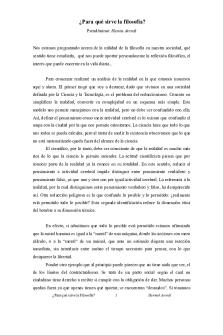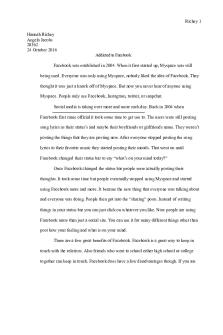PS5204 Lecture 27-11 - Dr Hannah Broadbent PDF

| Title | PS5204 Lecture 27-11 - Dr Hannah Broadbent |
|---|---|
| Course | Advanced and Applied Research Techniques |
| Institution | Royal Holloway, University of London |
| Pages | 6 |
| File Size | 113.9 KB |
| File Type | |
| Total Downloads | 92 |
| Total Views | 143 |
Summary
Dr Hannah Broadbent...
Description
27-11-18 Computerised cognitive testing and virtual reality for research Outline - Computerised vs pen and paper cognitive testing - Essential criteria for computerised cognitive tests - Task design and data collection - Psychometric and practical considerations - Ethical considerations - Virtual reality for research - Advantages of using VR for psychology research - VR setup and design - Application of VR to different research areas - Issues with VR research and future challenges - Ethical considerations - Group discussion worksheet Need for computerised cognitive testing - Organisational and processing ability, which reflect the development of specific neural networks, are not easily captured by traditional paper and pen neuropsychological tests (Luciana et al., 1999) - Testing in populations that require sensitive and robust measures of cognitive testing - Eg. older adults, children, individuals with dementia, neuropsychological impairments - Need for tests that are sensitive to age-related changes in cognitive function, and where performance correlates with specific regions in the brain Cognitive/neuropsychological assessments must be: - Reliable → Does it consistency measure a given construct? - Internal consistency; test-retest reliability - Valid → To what extent does the test measure what it intends to? - Predictive validity; concurrent validity; convergent validity; ecological validity - Efficient → Increasing need for fast and efficient cognitive testing - Cost-effective, easy and quick to administer, clear data interpretation - Sensitive (and specific) → Sensitivity: correctly identifying those with disorder → Specificity: correctly identify those without disorder - Positive Predictive Power (PPP) and Negative Predictive Power (NPP) Cognitive testing (many obvious applications) - Reaction time (RT) tasks - Simple RT tasks (response to stimuli in continuous performance test (CPT)) vs complex
-
RT tasks (eg. set-shifting or inhibition tasks) Attention - CPT tasks - stimuli can be presented at different interstimulus intervals Executive function (EF) - Stroop or go/no-go to examine impulse control and inhibition Visuomotor/perceptual skills - Trail Making Test; Computerized Perceptual Motor Skills Assessment (CPMSA) Learning and memory - Visual delayed match to sample task; groton maze learning test Spatial perception - Mental rotation tasks; visual spatial search task (VISSTA) Reasoning - Computerised adaptive testing (CAT) Problem solving - Computerised tower of london/hanoi tasks Dual and multitasking - Cognitive load tasks
Factors that affect computer-based testing - The computer-human interface (Kane & Kay, 1992) - The computer should be user friendly, and understandable - Timing of stimulus presentation and response latency - Effects of different displays on the appearance of stimuli - Should use the same display settings - Ability to use a computer/touch screen device - Make sure participants know how to use computers - Effects of prior computer experience on performance? - When would this be an issue these days given ubiquitous nature of computers? Computerised vs pen-and-paper tests - Computerised tasks - Advantages - Millisecond timing accuracy - Standardised administration and relatively error-free (test-retest reliability) - Automatic calculations of performance, accurate data collection and analysis - Less costly and time consuming - Reduced operator training - Assess multiple cognitive functions, multiple ppts - Culture-neutral - Disadvantages - Time consuming to learn programming skills - Dependent on experience with computer interface
-
- Ability to control keypads/mouse may differ across populations - Need for specific hardware/software - Overestimate accuracy of assessment Pen-and-paper tasks - Advantages - Portable - Allows greater depth of engagement with participant - Serial presentation. Can easily go back and forth to items, can be adjusted in real-time - More engagement with the task - Data confidentiality - Mixture of traditional cognitive tests and open-ended tasks - Disadvantages - Costly, time-consuming to administer - Specialist training for administration and interpretation - Prone to human error - Laborious data entry following testing - Timings include experimenter RTs - Not practical for large test batteries
Ethical considerations of computerised cognitive testing - Competence - Core issue: Researcher practices within area of competence. Knowledgeable and skilled in administration, scoring and interpretation - Test interpretation - Core issue: Simplification of interpretation (IF-THEN) - not based on theoretical knowledge or thorough understanding of the test - Responder issues - Core issue: Attitudes towards computers /computer anxiety or aversion - Equivalence of scoring across methods - Core issue: Tests must be empirically validated to determine their level of equivalence to their traditional counterparts, indicating that they produce basically the same results - Confidentiality - Core issue: Protected access to computer test results. Storing participant info with codes and scores in one place compromise confidentiality Why virtual reality? - Limitations of reality are removed - Boundless possibilities for creation of stimuli - Easily manipulated and instantaneously altered - benefit of flexibility - Allows psychologists to “think outside the box [of reality]” and “consider old problems in new ways” (Foreman, 2010)
-
High levels of experimental control, whilst preserving ecological validity (Blades, 1997; Blascovich et al., 2002; Zinchenko et al, 2010)
Advantages of VR as a research tool - Almost total control over the viewer’s attention (easily stress/highlight key stimuli to draw attention of the participant) - Bright, dynamic and interactive and so distraction less likely - Flexible programming - Can have real-time feedback (visual representation in milliseconds). - Possibility of multi-modal stimulation (audio, visual, tactile/haptic or olfactory). - VR invokes same cognitive processes as real environmental experience (Lee and Jung, 2005) - Precise data collection - High ecological validity Immersive vs non-immersive virtual reality - Immersive environments - Head mounted displays (HMD) or cave automatic virtual environments (CAVE) - Spatial immersion induces perception of being physically present in the nonphysical world - Surrounds individual with images, sounds and other stimuli for an absorbing experience - Looks authentic and enhances sense of actually being there - Desktop virtual environments (non-immersive) - Participants report feeling less subjective presence compared to IVR (Hoffman et al, 2003) - No differences in learning and performance in IVR and desktop (Morena and Mayer, 2004) - More simple and less expensive - Less distortion for navigation than with immersion head-sets (Westerman et al, 2001) Is navigation in VR really navigation? - Yes: because a participant must use visual cues to solve a spatial problem - No: real navigation relies heavily on moto, proprioceptive, and vestibular information - Use of idiothetic cues for path integration and allothetic cues for processing landmarks - Consideration for fMRI and VR navigation (immersion technology can’t be used without eliminating participant movements) VR in clinical research - Can be used to create complex scenarios - To help with - Claustrophobia - Fear of heights - PTSD
-
VR as exposure for treatment of anxieties, phobias, PTSD Can be used alongside other research techniques, as a means to examine changes in behaviours, attitudes, and thoughts VR allows for carefully graded exposure to stimuli/exposure manipulated with absolute precision Control over participant/client interactivity Beneficial not just in the visual dimension - Also allows for multisensory input (eg. auditory, haptic, olfactory to be experienced simultaneously)
VR and PTSD - Multimodal VR used to create virtual replica of PTSD-related scenes (including audio, visual, haptic feedback) - Based on traditional imaginal exposure therapy - World Trade Centre survivor – Case Study (Difede & Hoffman, 2002): - Gradually exposed to virtual planes flying over the World Trade Centre, jets crashing into the World Trade Centre with animated explosions and sound effects, virtual people jumping to their deaths from the burning buildings, towers collapsing, and dust clouds. - Results: a large (83%) reduction in depression, and large (90%) reduction in PTSD symptoms after completing VR exposure therapy. VR in forensic research - Empathy and aggressiveness in violent offenders - Participants to experiment in person a virtual situation of violence from the victim’s perspective VR in social psychology research - Social psychologists traditionally rely on created illusions of reality based on scenarios in which imagined or implied presence plays a major role (Korn, 1997) - Traditionally relies on videos, vignettes, confederates - More realistically usually = less experimental control - Studies on altruism or prosocial behaviour usually include self-report responses - In VR, participants can respond in a more natural way to stimuli - Kozlov and Johansen (2010) used avatars to ask participants for help under pressured situations - Measures actual helping behaviours rather than self—report answers about hypothetical situations - Even sophisticated high-level social behaviours can be observed and experimentally manipulated in simple VEs - A good compromise between experimental control and ecological validity VR issues in research and training - Unreliability of software - Compatibility difficulties
-
Requires specialist training and equipment Costly and time-consuming to design (depending on set-up) May rely on availability of technical support/programmers Human factors to consider
Future challenges for VR - Problem of effective presentation of objects (what criteria need to be met or minimal set of features need to be present for an object/environment to be considered ‘real’ and trustworthy)? - How immersive does the environment need to be? - Need to develop a new conceptual framework as term ‘virtual reality’ in psychology has previously been used to mean that of an altered state of consciousness. - Philosophical issue of when virtuality becomes reality - Need for more systematic studies using VR to combat issues regarding methodology and ethics Ethical considerations of VR research - Immersion in VR can have psychological effects that last after leaving the virtual environment (eg. Rosenberg et al., 2013; Peck et al., 2013) - Objective changes are subjectively perceived, and may lead to correlated shifts in value judgments - Immersive VR introduces new and dramatic ways of disrupting our relationship with the natural world (leading to possible neglect of the physical environment?) - This illusion of embodiment is more than with TV or video games - VR can elicit strong feelings of stress and fear (walking a plank over a pit) - Cybersickness - Health and safety (eg. eye-strain from binocular HMD displays) Pen-and-paper < computerised tasks < VR - Systematic presentation of cognitive tasks beyond what is available using traditional methods - Better control of the perceptual environment - More consistent stimulus presentation - More precise and accurate scoring - Increased quantification of discrete behavioural responses - Increased ecological validity for assessment of cognition and affect...
Similar Free PDFs

Dr Faustus Lecture 2
- 8 Pages

Lecture 17 - Dr. Chard
- 3 Pages

Lecture 2 - Dr. Tricas
- 1 Pages

DR Faustus Lecture Notes
- 1 Pages

Hannah Adrent summaries
- 4 Pages

Hannah Arendt - resumen libro
- 2 Pages

Hannah Arendt riassunto storia
- 6 Pages

Lecture 2 - DR MARIA MICHOU
- 7 Pages

Lecture 16 - Dr. Dana Sawchuk
- 2 Pages

Lecture 6 - Dr Jamie Barker
- 2 Pages

JOT2 Task1 Hannah Ingraham
- 7 Pages

Lecture 4 - Dr Hilary McDermott
- 1 Pages

Hannah arendt - asdfg
- 4 Pages
Popular Institutions
- Tinajero National High School - Annex
- Politeknik Caltex Riau
- Yokohama City University
- SGT University
- University of Al-Qadisiyah
- Divine Word College of Vigan
- Techniek College Rotterdam
- Universidade de Santiago
- Universiti Teknologi MARA Cawangan Johor Kampus Pasir Gudang
- Poltekkes Kemenkes Yogyakarta
- Baguio City National High School
- Colegio san marcos
- preparatoria uno
- Centro de Bachillerato Tecnológico Industrial y de Servicios No. 107
- Dalian Maritime University
- Quang Trung Secondary School
- Colegio Tecnológico en Informática
- Corporación Regional de Educación Superior
- Grupo CEDVA
- Dar Al Uloom University
- Centro de Estudios Preuniversitarios de la Universidad Nacional de Ingeniería
- 上智大学
- Aakash International School, Nuna Majara
- San Felipe Neri Catholic School
- Kang Chiao International School - New Taipei City
- Misamis Occidental National High School
- Institución Educativa Escuela Normal Juan Ladrilleros
- Kolehiyo ng Pantukan
- Batanes State College
- Instituto Continental
- Sekolah Menengah Kejuruan Kesehatan Kaltara (Tarakan)
- Colegio de La Inmaculada Concepcion - Cebu


